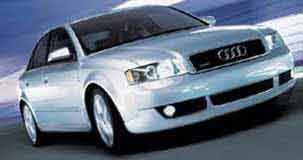

|
Exhaust ,Technical Tips, 1986-90 5000/200TQ
Exhaust System Back pressure - Running High Boost
Running higher boost can also affect the exhaust manifold/system. Cracked exhaust manifolds and or broken exhaust studs can result even running stock levels of boost. The catalytic converter and muffler system can get plugged or restricted over the life of a car which may cause poor running with a lower power output. A high mileage/old catalytic converter can contribute a lot of Back pressure in the exhaust system. The exhaust Back pressure should be tested at full throttle up to the rev limit at stock boost levels and when running higher boost levels for comparison. The pre-catalytic sniffer pipe mounted after the Turbo can be used to connect a low pressure (0-15psi) fuel pressure gauge to measure the Back pressure. On the 86-90 5000/200TQ, tests indicate that about 3 psi is seen with the catalytic temporarily removed and a straight pipe installed when running 1.8 bar in the MC engine. I have measured up to 6.5 psi exhaust Back pressure with an old Catalytic Convertor installed. Catalytic Converter meltdown can occur with overly rich mixtures at sustained full throttle running when immediately followed by normal lean running or idling.
EXHAUST MANIFOLD LEAKS - BROKEN STUDS
I also found the source of the exhaust leak that I've been hearing in the morning, exhaust manifold stud for #1 cylinder broke off when I attempted to tighten the loose nut. It may be a better idea to replace the stud and nut if you come across any loose nuts. The service bulletins state that this was a problem until 1987 when they installed improved exhaust studs. This looks like a fun project! It may be easier to remove the head with the intake and exhaust manifolds attached than to try and pull off just the exhaust manifold.
ROTTEN EGG SMELL FROM CATALYTIC CONVERTER
The sulphur smell from the exhaust, is actually caused by running the engine/cat convertor slightly lean for long periods and then running under a rich condition (ie going up a hill under heavy load) This is when the sulphur smell (rotten egg) is produced.
Under relatively lean conditions, the sulphur found in gasoline is converted to sulphur trioxide, then during the rich running condition the sulfur trioxide is converted into hydrogen sulphide (rotten egg smell) within the catalytic converter.
Audi of America issued a service bulletin Group 24, #92-04 which detailed this problem. They list the cause as : the gasoline sulphur content and the characteristic of catalytic convertor to store sulphur compounds and release them during rich engine running conditions.
Switching gasoline brands may help. The Oxygen sensor may also need to be replaced to correct a fuel injection mixture problem.
Copyright © SJM Autotechnik™ , all rights reserved
Return to Troubleshooting Tips page. Return to SJM Autotechnik™ main page.
|
| About Us Privacy Policy Terms of Use Links Customer Service Safety Information Home |